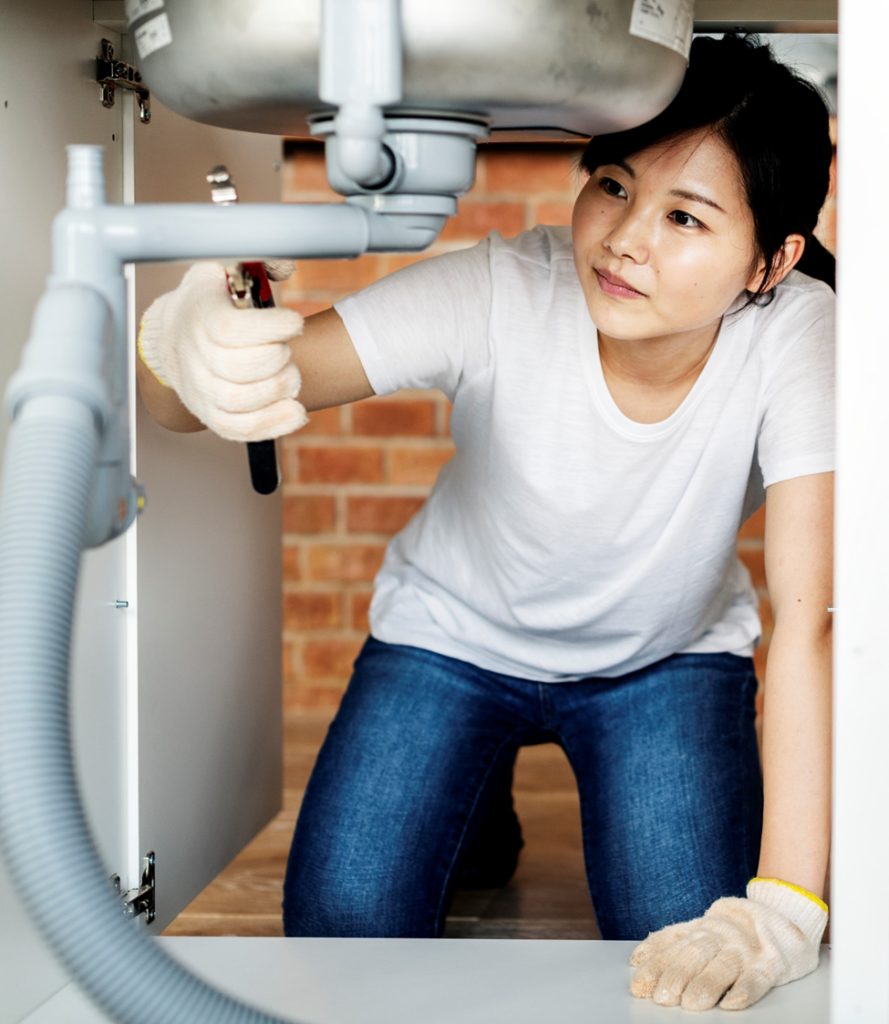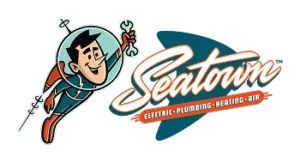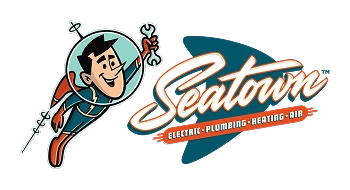Here’s How to Tackle Common Plumbing Problems

As one of the largest and most vital systems in your home, your plumbing system is bound to have problems from time to time. Whether you’re dealing with dripping faucets, clogged drains, or leaking pipes, everyone encounters plumbing problems at some point.
While some issues may require professional assistance, many common plumbing problems can have a DIY treatment. Here’s how to tackle common plumbing problems expertly and safely, complete with tips from the pros at Seatown Services.
Dripping Faucets
One of the most common plumbing issues is a dripping faucet. Beyond the annoying sound, a dripping faucet can waste a significant amount of water and increases your utility bills.
Often, this is caused by a worn-out washer or O ring, which you can easily replace on your own. However, some dripping faucets are caused by corrosion or poor faucet installation, which may require a replacement fixture.
If your faucet is dripping:
- Start by turning off the water supply to the affected fixture. You can do this by shutting off the valve under the sink.
- Once the water is off, disassemble the faucet handle and replace the old washer or O-ring with a new one. Be sure to use the correct size and type of replacement parts for your specific faucet model.
Clogged Drains
Clogged drains are an annoying plumbing problem that can majorly disrupt your activities in the kitchen or bathroom. Often, clogs are caused by hair, soap scum, food particles, or grease, depending on where the clog occurs.
Here’s what to do for a clogged drain:
- For minor clogs, try using a plunger to dislodge the blockage. Make sure there’s enough water in the sink or tub to cover the plunger’s cup and create a tight seal. Plunge firmly and consistently for a minute or so, then check if the water drains. If the clog persists, consider using a drain snake.
- For buildup clogs, you can try a homemade solution of baking soda and vinegar. The chemical reaction between these chemicals can help break up buildup on your pipes. First, pour a cup of baking soda into the drain, then follow with a cup of white vinegar. Leave the solution for about 15 minutes, then flush with hot water.
- Avoid chemical drain cleaners. While these are often a go-to, they pose a health hazard and can damage your pipes with regular use. if the clog is that severe or persistent, call a professional plumber.
Running Toilets
A running toilet is loud and irritating, but it can cause bigger problems than that. The constantly running water can waste gallons, not to mention increasing your water bills. Typically, the issue is caused by a faulty flapper valve or a problem with the fill valve.
To diagnose a running toilet:
- Remove the tank lid and inspect the flapper valve. If it appears damaged or doesn’t form a tight seal, replace it with a new one.
- You can also check the fill valve for any issues. Adjust the water level if necessary and replace the fill valve if it’s not functioning correctly.
Leaking Pipes

Leaking pipes can cause a lot of problems, including water damage, mold growth, and structural issues if not addressed quickly. Often, pipe leaks are a result of corrosion, high water pressure, and loose fittings.
To fix a leaky pipe:
- Start by turning off the water supply to the area. For small leaks, use a pipe clamp or wrap the affected area with pipe repair tape.If the leak is at a joint, tighten the fittings with a wrench.
- For larger or more complex leaks, it’s best to consult a professional plumber.
Low Water Pressure
Low water pressure can be frustrating, especially in the shower or kitchen sink. The causes of low water pressure can range from mineral deposits in the aerator to issues with the water supply line.
To fix low water pressure:
- Begin by checking the aerators on faucets and showerheads for mineral buildup. Remove the aerator, clean it, and reattach it.
- If the lower water pressure persists, check for any leaks in the water supply line and repair them promptly. If the issue persists, call a plumber to determine the root cause.
Water Heater Issues
A malfunctioning water heater can disrupt your daily routine, particularly in the colder months. Common water heater problems include no hot water, inadequate hot water, or strange noises coming from the tank.
To fix water heater issues:
- Start by checking the thermostat settings on the water heater. Ensure that it is set to the appropriate temperature, which is typically around 120°F.
- If you have no hot water or insufficient hot water, it may be a faulty heating element or sediment buildup in the tank. Flushing the tank and replacing the heating element may resolve the issue. If you’re not comfortable doing this on your own, it’s best to call in a pro.
Frozen Pipes
In colder climates, frozen pipes are a common plumbing concern during winter. When water freezes, it expands, putting immense pressure on pipes and increasing the risk of cracks or bursts.

If you suspect a frozen pipe:
- Keep the affected faucet open and use a heat source, such as a hairdryer or a heating pad, to thaw the pipe gradually. Never use an open flame to thaw your pipes, as you can start a fire.
- To prevent frozen pipes, insulate exposed pipes in unheated areas of your home, such as the basement or attic.
Garbage Disposal Issues
Garbage disposals are prone to clogs, jams, and unpleasant odors. Avoid putting items like bones, grease, and fibrous vegetables down the disposal, as they can lead to problems.
If your garbage disposal is clogged:
- Use a hex key to manually turn the disposal’s blades and dislodge the obstruction.
- Try using a mixture of baking soda and vinegar to break up the debris in the garbage disposal. This is helpful if the buildup is from grease and food particles.
- If these methods don’t work, contact a plumber to address the garbage disposal problems.
Sump Pump Failures
For homes with basements, a functioning sump pump is crucial to prevent flooding during heavy rain or snowmelt. Common sump pump issues include pump failure, float switch problems, or power outages.
Check your sump pump by:
- Pouring water into the pit to activate the pump. If it doesn’t turn on or your notice unusual sounds, it may be time for maintenance or replacement. Ensure that the float switch moves freely.
- Consider installing a backup power source, such as a battery- or water-powered sump pump to address power outages.
Foul Odors

Unpleasant odors emanating from drains are often a result of trapped debris, bacteria, or mold. No matter how much you clean, you won’t be able to address the odors because they’re coming from deep inside your pipes.
- Start by removing and cleaning the drain stoppers in sinks and tubs. Use a mixture of baking soda and vinegar to break down organic matter in the drains.
- For persistent odors, consider using a bacterial drain cleaner or an enzyme-based cleaner, which can help break down organic material in the pipes.
- Additionally, running hot water down the drains regularly can prevent the buildup of grease and soap scum.
To address foul odors:
Septic System Issues
If your home is not connected to a municipal sewer system, septic system problems can arise. Signs of trouble include slow drains, foul odors, or pooling water in the yard. Regular septic tank pumping can help to prevent backups and maintain the system’s efficiency.
If you notice signs of septic system issues, don’t try to DIY. Consult a professional plumber to assess the problem, since this is a bigger job than most homeowners can handle.
Water Quality Issues
Issues with water quality can affect both well and municipal water supply. Common problems include discolored water, a metallic taste, or a rotten egg odor.
To address water quality concerns:
- Install water filters or water softeners as needed.
- If the problem persists, consult a plumber for a thorough analysis and appropriate solutions.
Water Hammer
A “water hammer” is a loud banging noise that happens in the pipes when the water is suddenly turned off. In addition to being annoying, water hammer can lead to pipe damage over time.
To address water hammer, install water hammer arrestors or adjust the water pressure at the main valve.
Should You Handle Your Own Plumbing Repairs?

Tackling your own plumbing repairs can be a cost saver, but keep in mind that you could end up doing more damage and costing yourself more money if you don’t have the skills necessary for DIY plumbing repairs.
Here are some things to keep in mind if you want to tackle your own plumbing problems:
- Make sure you know what the actual problem is. If you’re not sure, or you think the problem could be bigger than just the one sign, it’s better to contact a pro for a consultation.
- Gather all the tools and supplies you need for the project, start to finish. Double check that your tools are the appropriate size for each stage of the project and fitted to your existing plumbing system. You don’t want to have to stop in the middle to get what you need to complete the job, or worse, install something that doesn’t fit and end up with bigger issues.
- Know where the water supplies are, including the main. Shutting off the water is the most important step in any plumbing project.
- Be prepared to get dirty. Plumbing is rarely a neat and clean job, so plan for a mess by wearing old clothes and putting protective coverings on your floor.
- Keep a plumber’s number on hand. If the project gets out of control, you don’t want to scramble to call the right contractor.
Need Plumbing Repairs or Upgrades?
While these plumbing problems happen from time to time, some issues need a professional touch. If you need help with your plumbing, Seatown Services is available. Contact us today to schedule your appointment!

